Ladybird beetles are frequently portrayed in childrens’ books and nursery rhymes, but few know that they possess noxious chemicals which wreck havoc on taste buds when consumed. In fact, they are known to emit a lingering odour when disturbed or smashed, and can ruin the taste of wine produced from the vineyards. Brighter ladybirds with distinct spots appear to taste the most rancid, leading birds to recognize these unsavory lunch targets from afar after an initial bad experience.
This photo series focuses on a rare genus of spiders (Paraplectana) together with some other arthropods that may have evolved to mimic ladybird beetles based on the birds’ natural avoidance of these little beetles. The mimicry is amazingly good and had quite a lot of people fooled!
All photos in this series were shot with my Nikon D800, Tamron 90mm and Raynox DCR-250. Check out my Macro Equipment page for more details on my setup.
Ladybird beetle (Coelophora inaequalis)
One of the classic ladybird beetles found in Singapore bearing the distinct red colour and black spots. For more photos of ladybirds, check out my ladybird beetle checklist.
Red ladybird mimic spider (Paraplectana sp.)
Those with an untrained eye wouldn’t think too much when they see this “ladybird beetle”.
Red ladybird mimic spider (Paraplectana sp.)
This bright-bodied, spotted creature turned out to be a beautiful spider! This is a perfect example of Batesian mimicry where a species imitates the warning signals to get the protection with its perceived foul taste.
Red ladybird mimic spider (Paraplectana sp.)
Another possible reason for the bright markings, is that it has an instant correlation with danger, and other animals would instinctively steer clear of it. Possibly the same reason why stop, warning or danger signs are almost always in red or yellow.
Red ladybird mimic spider (Paraplectana sp.)
This spider is incredibly rare, with my second sighting only possible with some tip-offs after over 150 field trips 3 years later.
Ladybird mimic spider (Paraplectana sp.)
As usual, when disturbed, it turned around to try to scare me. BOO!
Ladybird mimic spider (Paraplectana sp.)
My third sighting of this spider was much later, about 4 to 5 long years after the last one!
Ladybird mimic spider (Paraplectana sp.)
Most of the specimens are really small, at about 5mm wide.
Ladybird mimic spider (Paraplectana sp.)
Each sighting would still be super exciting and an opportunity to improve on my old shots.
Ladybird mimic spider (Paraplectana sp.)
Of course, I made sure to document the spider from every angle, just in case!
Yellow ladybird mimic spider (Paraplectana sp.)
This adorable yellow version of the ladybird-mimic was first spotted (no pun intended) by another group of macro photographers from Singapore in 2015. It took me over a year, but I finally found an extremely gravid specimen on the last day of 2016!
Yellow ladybird mimic spider (Paraplectana sp.)
Dorsal view. If not for the legs, most others would have thought of ladybird rather than spider!
Yellow ladybird mimic spider (Paraplectana sp.)
Again, she turned around in an attempt to scare me.
Ladybird mimic spider (Paraplectana sp.)
Not all species in Paraplectana have black spots like the ones above. They are recognized by the semi-circular abdomen, and sometimes confused with Cyrtarachne.
Ladybird mimic spider (Paraplectana sp.)
These Paraplectana are surprisingly tiny. Those featured here were between 5mm to 8mm wide.
Ladybird beetle (Rodolia sp.)
Despite the lack of spots, the spider above could very well be mimicking this ladybird beetle!
Ladybird mimic spider (Paraplectana sp.)
The last Paraplectana in this series doesn’t seem to match any of the ladybird beetles that I have shot before. This spider could be new to science and does not have name yet. Among my friends, we called this the golden coin spider.
Ladybird mimic spider (Paraplectana sp.)
I have at least 3 records of this spider but none were mature.
Red ladybird mimic spider (Paraplectana rajashree) ©2015 Sumukha JN
This Paraplectana was described in 2015 from India by Javed Ahmed, named after naturalist and birder Rajashree Khalap. Previously, publications on Paraplectana had never documented the internal genitalia and this seems to be the first. It remains to be verified if the ones found in Singapore are the same as this species.
Tortoise orb weaver (Encyosaccus sp.)
Another brilliantly coloured spider from the same family, Encyosaccus does not have the same abdominal pattern but the same bright colours would lead one to believe that they could be ladybird mimics too. Read my series on the Adorable Tortoise Orb Weavers from the Amazon.
Ladybird-mimic fungus beetle (Stenotarsus pardalis)
Spiders were not the only ones in the mimicry game. This handsome fungus beetle is also commonly mistaken to be a ladybird beetle for its red body and black spots. View my Handsome Fungus Beetle Checklist.






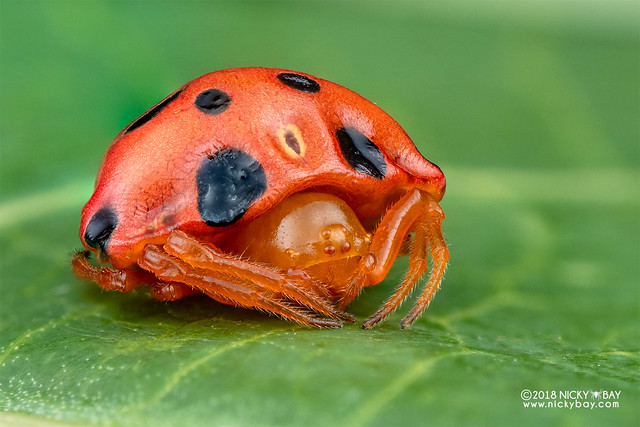














Conclusion
There are other known ladybird mimicking spiders, such as some species of Eresus which could be found in Europe. Do you know of other ladybird mimicking creatures? Let me know in the comments below, I would love to hear from you!



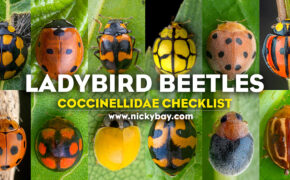
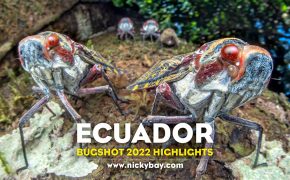
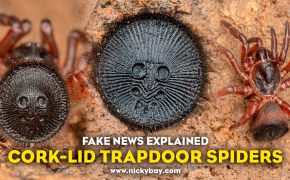











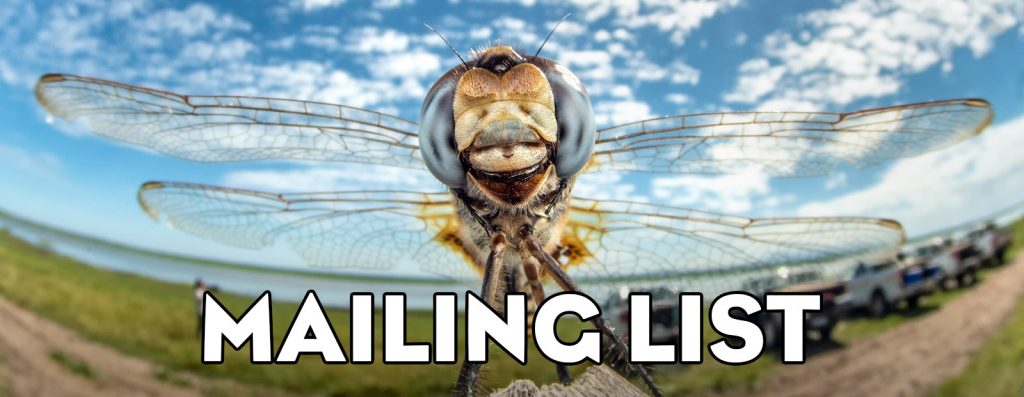
Jacques Demers
Geetings Nicky,
Your insect and spider pictures are beautiful !
I had the chance of visiting Singapore in the past; I even took some insect pictures in the beautiful botanical gardens and I wish I will visit again one day; I’m realizing how beautiful and varied arthropods are in your incredible country (and I love the food too !) I do some macrophotography myself and some of my images are on Flickr if you search for “jadeclic” in people. I still have much to learn and your images are very inspiring. Thanks for showing them to us !! Best Regards – Jacques Demers MD, from St-Bruno-de-Montarville (near Montreal, Canada)